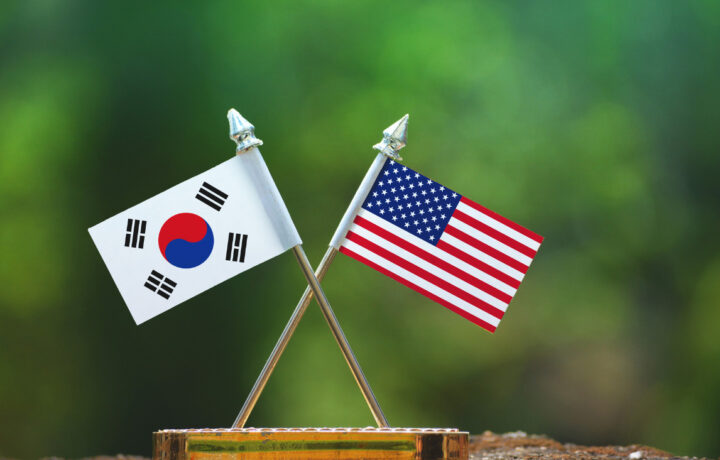The largest naval shipbuilder in the United States has too much work. For some companies that would be a happy problem to have, but Virginia-based Huntington Ingalls Industries (HII) says it could use some assistance. It announced on Monday that it signed a wide-ranging agreement with South Korean shipbuilder Hyundai Heavy Industries (HHI).
The memorandum of understanding (MOU) was signed at the Navy League’s Sea-Air-Space Symposium at National Harbor, MD, the largest global maritime expo in North America. The MOU will allow the two shipbuilders to collaborate on each other’s projects.
“Today’s agreement reflects our commitment to explore all opportunities to expand U.S. shipbuilding capacity in support of national security,” HII Executive Vice President and President of Ingalls Shipbuilding Brian Blanchette said in a statement. “By working with our shipbuilding allies and sharing best practices, we believe this MOU offers real potential to help accelerate delivery of quality ships.”
The Rise of the South Korean Shipyards
Compared to other nations in the Pacific Rim, the Republic of Korea (South Korea) is actually a late comer in the shipbuilding sector, and it had to overcome barriers of entry. It is a late industrialized middle power with limited resources and population, a June 2023 report from Maritime Executive noted.
However, during the military dictatorship of Park Chung-hee, who served as South Korea’s president from 1963 to 1979, the shipbuilding industry was heavily subsidized, and that helped transform shipbuilding into one of the nation’s major economic mainstays.
Moreover, as many western countries, including the United States, opted to discontinue shipbuilding at the end of the Cold War that wasn’t the case with Seoul. It was able to respond to increased demand for commercial ships in the late 1990s and early 2000s, creating the ecosystem that exists today with South Korea now securing its places as one of the world’s largest shipbuilders.
While HIIs Ingalls Shipbuilding in Pascagoula, Miss., is just one of two U.S. shipyards that are building the United States Navy’s Arleigh Burke-class Flight III guided-missile destroyers, and is also the only shipyard that produces the amphibious assault ships, Hyundai already builds a variant of the guided-missile destroyer. The latest hull was delivered last November, USNI News also reported.
HHI currently owns the world’s largest shipyard, located in Ulsan, South Korea, while it maintains around 10% of the world’s shipbuilding market.
Leveraging the Combined Expertise of HII and HHI
According to the joint statement from the companies, the strategic partnership will aim to leverage the combined expertise and resources of each of the companies to advance technological innovation, maximize production efficiency, and strengthen the global defense industry.
“This partnership marks a new milestone for both of our companies and provides us with the unique opportunity to expand our expertise in shipbuilding,” added Won-ho Joo, chief executive of the naval & special ship business unit at HHI. “We look forward to working with HII to explore new possibilities and deliver even greater value to our customers.
Moreover, the efforts applied under the MOU will serve to increase the collective maritime industrial base strength of both the United States and South Korea, the companies suggested.
The U.S. Navy Has Been Exploring Options
Former Secretary of the Navy Carlos Del Toro visited facilities in both South Korea and Japan, and even as President Donald Trump has made bringing manufacturing back to the United States it is apparent that shipbuilding may require those foreign partners.
The current U.S. capacity of the global shipbuilding market is only 0.13%. In total, China has 232 times the shipbuilding capacity of the United States, maintaining 50% of the market, while South Korea and Japan follow at nearly 30% and 17%, respectively.
Testing the South Korean Waters
Exactly what the HII and HHI partnership will bring is yet to be seen, but the United States Military Sealift Command (MSC) experienced the capabilities of what South Korea can provide earlier this year as the Lewis and Clark-class dry cargo ship USNS Wally Schirra (T-AKE-8) completed a seven-month regular overhaul (ROH) at Hanwha Ocean, Gyeongsangnam-do, South Korea.
It marked the first time that a Republic of Korea shipyard had bid on and won an ROH contract of this scale for an MSC vessel. The same facility is now handling the maintenance for the Henry J. Kaiser-class replenishment oiler USNS Yukon (T-AO-202) as part of another contract signed last November.




